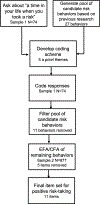A Mixed-Methods Approach to Refining and Measuring the Construct of Positive Risk-Taking in Adolescence
- PMID: 36358015
- PMCID: PMC10464509
- DOI: 10.1111/jora.12807
A Mixed-Methods Approach to Refining and Measuring the Construct of Positive Risk-Taking in Adolescence
Abstract
Adolescence is a peak period for risk-taking, but research has largely overlooked positive manifestations of adolescent risk-taking due to ambiguity regarding operationalization and measurement of positive risk-taking. We address this limitation using a mixed-methods approach. We elicited free responses from contemporary college students (N = 74, Mage = 20.1 years) describing a time they took a risk. Qualitative analysis informed the construction of a self-report positive risk-taking scale, which was administered to a population-based sample of adolescents (N = 1,249, Mage = 16 years) for quantitative validation and examination of associations with normative and impulsive personality. Sensation seeking predicted negative and positive risk-taking, whereas extraversion and openness were predominantly related to positive risk-taking. Results provide promising evidence for a valid measure of adolescents' engagement in positive risks.
Keywords: negative risk-taking; personality; positive risk-taking.
© 2022 Society for Research on Adolescence.
Conflict of interest statement
Declaration of Conflicting Interests
The authors declared no conflicts of interest with respect to authorship or the publication of this article.
Figures
References
-
- Bohnert A, Fredricks J, & Randall E (2010). Capturing Unique Dimensions of Youth Organized Activity Involvement: Theoretical and Methodological Considerations. Review of Educational Research, 80(4), 576–610. 10.3102/0034654310364533 - DOI
-
- Braun V, & Clarke V (2006). Using thematic analysis in psychology. Qualitative Research in Psychology, 3(2), 77–101. 10.1191/1478088706qp063oa - DOI
-
- Harris MJ (Ed.). (2009). Bullying, rejection, & peer victimization: A social cognitive neuroscience perspective. Springer Publishing Company.
Publication types
MeSH terms
Grants and funding
LinkOut - more resources
Full Text Sources
Medical


